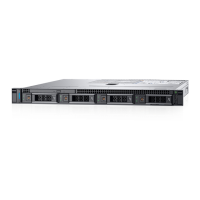Option Description
Write Data CRC
When set to Enabled, DDR4 data bus issues are detected and corrected during 'write' operations.
Two extra cycles are required for CRC bit generation which impacts the performance. Read-only
unless System Profile is set to Custom. This option is set to Disabled by default.
Memory Patrol Scrub Sets the memory patrol scrub mode. This option is set to Standard by default.
Memory Refresh Rate Sets the memory refresh rate to either 1x or 2x. This option is set to 1x by default.
PCI ASPM L1 Link Power
Management
Enables or disables the PCI ASPM L1 Link Power Management. This option is set to Enabled by
default.
Determinism Slider Set the system determinism by Power Determinism or Performance Determinism. This option is
set to Power Determinism by default.
Efficiency Optimized Mode Efficiency Optimized Mode maximizes Performance-per-Watt by opportunistically reducing
frequency/power. Enables or disables the Efficiency Optimized Mode.
System Security
To view the System Security screen, power on the system, press F2, and click System Setup Main Menu > System BIOS > System
Security.
Table 29. System Security details
Option Description
CPU AES-NI Improves the speed of applications by performing encryption and decryption by using the
Advanced Encryption Standard Instruction Set (AES-NI). This option is set to Enabled by
default.
System Password Sets the system password. This option is set to Enabled by default and is read-only if the
password jumper is not installed in the system.
Setup Password Sets the setup password. This option is read-only if the password jumper is not installed in the
system.
Password Status Locks the system password. This option is set to Unlocked by default.
Table 30. TPM 1.2 security information
Option Description
TPM Security
NOTE: The TPM menu is available only when the TPM module is installed.
Enables you to control the reporting mode of the TPM. The TPM Security option is set to Off by default. You
can only modify the TPM Status, and TPM Activation if the TPM Status field is set to either On with Pre-boot
Measurements or On without Pre-boot Measurements.
When TPM 1.2 is installed, the TPM Security option is set to Off, On with Pre-boot Measurements, or On
without Pre-boot Measurements.
When TPM 2.0 is installed, the TPM Security option is set to On or Off. This option is set to Off by default.
TPM Information Changes the operational state of the TPM. This option is set to No Change by default.
TPM Firmware Indicates the firmware version of the TPM.
TPM Status Specifies the TPM status.
TPM Command Controls the Trusted Platform Module (TPM). When set to None, no command is sent to the TPM. When set to
Activate, the TPM is enabled and activated. When set to Deactivate, the TPM is disabled and deactivated.
When set to Clear, all the contents of the TPM are cleared. This option is set to None by default.
Table 31. TPM 2.0 security information
Option Description
TPM Information Changes the operational state of the TPM. This option is set to No Change by default.
34 Pre-operating system management applications

